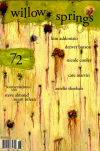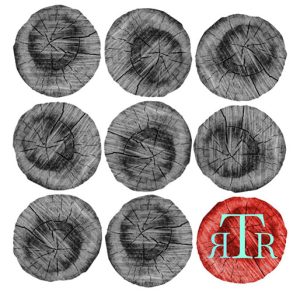Willow Springs – Fall 2013
Willow Springs is a long-standing literary magazine, publishing works by well-known and up-and-coming writers alike for the past 30 years. The first thing that struck me when I began reading it was that there was not a specific theme noted anywhere or an editor’s note. While the magazine’s goal is to “engage its audience in an ongoing discussion of art, ideas, and what it means to be human,” this is a very general goal that can go in a number of directions. While it isn’t necessary to have a theme, the individual pieces themselves work together in a way to create themes in the reader’s mind; the one that stood out to me was of the things inside us—the hidden talents we aren’t aware of; the twisted desires we will never admit; the work of art we haven’t unlocked.
Willow Springs is a long-standing literary magazine, publishing works by well-known and up-and-coming writers alike for the past 30 years. The first thing that struck me when I began reading it was that there was not a specific theme noted anywhere or an editor’s note. While the magazine’s goal is to “engage its audience in an ongoing discussion of art, ideas, and what it means to be human,” this is a very general goal that can go in a number of directions. While it isn’t necessary to have a theme, the individual pieces themselves work together in a way to create themes in the reader’s mind; the one that stood out to me was of the things inside us—the hidden talents we aren’t aware of; the twisted desires we will never admit; the work of art we haven’t unlocked.
The scarecrow is a prevalent character in several of the pieces in this issue including “if the scarecrow weren’t a scarecrow” by Denver Butson. In this poem, the actions of a real human being are examined through the shell of a man, the scarecrow:
if the scarecrow weren’t a scarecrow
he might be you or he might be me
or he might just be someone else
who is neither you nor me
someone perhaps who doesn’t even know
that he or she is not a scarecrow
someone who does not feel the pang
of not being who he might have been
as you and I and the scarecrow himself
feel such a pang
every time we consider
how things might have been different
Nicole Cooley’s poem, “The Pregnant Doll,” was an especially intriguing look at society’s portrayal of pregnancy and the post-pregnant body of a woman. The real-life experiences of a woman delivering a baby are held in stark contrast to the “Doll who wears high heels and a pink nightgown / over her emptiness.” There is a very raw reality exposed in this poem over what happens to the human body when giving birth, something not always beautiful or miraculous. The lines “a household for another body” and “a cut steak leaking blood onto a plate” kept me reading the poem over and over.
While there were several works of fiction in this issue, the one that stood out to me the most was “Prey” by Maxim Loskutoff. I was torn between loving and hating it simultaneously. The narrator is Derek—a loner, slightly overweight college student who works at a taco place and has a female, pet python named Voldemort. Derek is not a lovable character, but this helps the reader to better understand the low point he has reached when we come into his story:
I wake from a dream knowing that something, or someone, is in my bed. All the muscles in my arms and back are rigid. I roll over. A single, lidless eye gleams on the pillow beside me, milk chocolate brown with an elliptical pupil, swollen now in the near-dark. It’s Voldemort, smiling at me with her long, double-hinged jaws.
While I’m generally not a snake-lover, this story kept me turning the pages until the very end.
There are also two interviews that are definitely worth the time and energy, one with Steve Almond and the other with Susan Orlean. In Almond’s interview, he talks about writing moral pieces that try to cut through preconceived notions and sometimes turn political. A word he uses to describe the writing experience that I particularly liked was obsessive. Sometimes we write about things we’re obsessed with; we’re all obsessed with something, and writing is an avenue for that. However, there also needs to be an element of mystery, even to the writer. Almond says, “There should be lots of stuff you don’t know. That’s what allows you to surprise yourself and keep a preserved sense of mystery in your work.”
In Susan Orlean’s interview, she speaks to her curiosity over ordinary places and situations of life. Her nonfiction works look to explore these things, sometimes those things she fears or doesn’t even like, to develop a better understanding of it. When questioned on how much of her interviewing techniques are learned and how many are natural, Orlean again refers to this observation and curiosity writers should have. We should observe naturally to some degree, but we can learn what situations to explore or get a sense of which people will be interesting and provide the most valuable information.
While I found a theme throughout this issue, there are many more threads that can be linked in these pieces, not only in the poems and fiction but also in the interviews. See which ones you find and thread your way through Willow Springs 72.
[willowsprings.ewu.edu]





